The ISC Class 12 Biology specimen paper 2024-25 is released by the Council for the Indian School Certificate Examinations (CISCE). The Indian School Certificate (ISC) class 12 Biology specimen paper for the year 2024-25 is published on the official website of the CISCE for the annual exam preparation. Specimen papers are very important in the preparation of the actual exam.
The Biology subject is important in the curriculum of class 12 of the CISCE, especially for those students who plan to take the medical career. For the convenience of students, we are providing the ISC class 12 Biology specimen paper for the academic year 2025 in PDF format.
ISC Class 12 Biology Specimen Paper 2024-25
CISCE is going to publish the ISC Class 12 Biology Specimen paper online for the upcoming 2025 exam. The Specimen Paper 2025 for the Biology subject is important in understanding the concepts and important topics for the board theory exam. The specimen paper is the best reference guide from where a student should prepare for the exam. Biology as a subject has a vast syllabus consisting of various diagrams and concepts. navigating through the sample paper will give students a solid idea about how to prepare for the upcoming board exam.
The majority of the questions on the National Eligibility Cum Entrance Test (NEET) are from the biology syllabus for ISC Class 12. Gaining a solid understanding of the subject will come from thoroughly comprehending the material and working through the ISC Class 12 Biology Specimen Paper. Additionally, students familiarize themselves with the examination’s question kinds, mark distribution, etc.
ISC Biology Class 12 Specimen Paper 2025 Overview
The ISC Class 12 Biology subject is crucial for aspirants planning to become a medical warrior ahead in their life. The Biology subject exam paper is divided into many sections, each having different weightage. The total time allowed to solve the exam paper is 3 hours. The details of the ISC Biology Class 12 paper is given below based on the available ISC Class 12 Biology Specimen Paper 2024-25.
Maximum Marks: 70 Marks
Time Limit of the Exam: 3 hours
Time allocated for Reading the Paper: Additional 15 Minutes
Number of Sections: 4
ISC Biology Class 12 Specimen Paper 2024-25
The Biology specimen paper of the ISC Class 12 contains many important instructions. Students must clearly read the instructions and advice given on the question paper before beginning their exam. These instructions contain many important details regarding the exam. The important instructions that students should follow in the ISC Biology Paper Class 12 is given below.
| Important Instructions |
|
ISC Class 12 Biology Specimen Paper 2025 PDF
The PDF of the ISC Biology specimen paper 2025 has been given below for students. Students must go through the questions given in the specimen paper so that they can have an idea about the type of questions asked in the exam. They must thoroughly solve the specimen paper provided by the council to score good marks in the exam.
ISC Class 12 Biology Specimen Paper 2025 PDF
ISC Class 12 Biology Specimen Paper 2025 Advantages
The ISC Class 12 Biology Specimen Paper has a huge importance and provides many advantages. The advantages of the Specimen Paper of the Biology subject is given below.
- Students learn about the format and weighting of the marks in exams.
- The specimen paper offers helpful review in advance of the board examination.
- Students are given a preview of the kinds of questions that will be asked in the real exam.
- Students who practice the specimen paper will find it easy to manage their time for exams and complete the entire paper on time.
- Students can evaluate how well they prepared for exams by themselves and make adjustments to improve.
ISC Class 12 Biology Specimen Paper Previous Year
Along with the ISC class 12 Biology specimen paper for 2025, we have also provided the specimen paper from the previous year as there are chances that questions may be repeated from the previous papers.
Section A – 20 Marks
Question 1
Answer the following questions briefly.
(i) Birds build their nests in trees. Identify the type of ecological relationship between the birds and the trees. [1]
(ii) A doctor examines the symptoms of a patient who has a high fever with chills. What disease could this patient be suffering from? [1]
(iii) The genome size of an organism is around 109 base pairs. Calculate the length of its genome in metres. [1]
(iv) What is the probability of having a male child if the father’s sperm carries an X chromosome? [1]
(v) In the year 2021, the population of fish in a lake was 500. After one year, a biologist found that the population had an average natality of 120, average mortality of 65, immigration was 25 and emigration was 30. Calculate the total
number of fish that were present in the lake in 2022. [1]
(vi) The Gross Primary Productivity (GPP) of the Amazon rainforest is approximately 3000 g C/m² /yr and the respiration losses (R) of 1800 g C/m² /yr. Calculate the Net Primary Productivity (NPP) of this ecosystem. [1]
(vii) Identify if the given set of structures can be classified as homologous or analogous structures. [1]
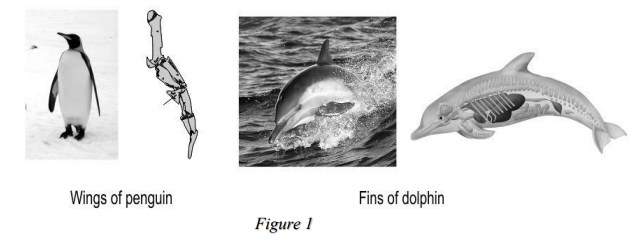
(viii) Suggest an effective molecular technique that can be used to reduce the expression of defective genes in the nematode parasite. [1]
(ix) Which one of the following is an example of naturally acquired active immunity? [1]
(a) Recovering from chickenpox
(b) Newborns gaining antibodies from breast milk
(c) Getting vaccinated against the COVID-19 virus
(d) Taking antibiotics against a urinary tract infection
(x) If oogenesis occurs conventionally in a human, which one of the following represents the correct ploidy levels of the primary and secondary oocytes? [1]
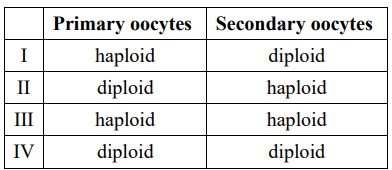
(a) I
(b) II
(c) III
(d) IV
(xi) Assertion: The external application of insecticides is negligible for Bt crops.
Reason: Bt crops contain a gene that produces toxins harmful to certain insects.
Which one of the following is correct? [1]
(a) Both Assertion and Reason are true, and Reason is the correct explanation for Assertion.
(b) Both Assertion and Reason are true, but Reason is not the correct explanation for Assertion.
(c) Assertion is true and Reason is false.
(d) Both Assertion and Reason are false.
(xii) Assertion: The spent slurry after biogas production is used as a fertiliser for soils that are nitrogen deficient.
Reason: Only nitrogen from the slurry is utilised in the production of biogas.
Which one of the following is correct? [1]
(a) Both Assertion and Reason are true, and Reason is the correct explanation for Assertion.
(b) Both Assertion and Reason are true, but Reason is not the correct explanation for Assertion.
(c) Assertion is true and Reason is false.
(d) Both Assertion and Reason are false.
(xiii) A student aims to insert a foreign gene into the plasmid shown below for an experiment. [1]
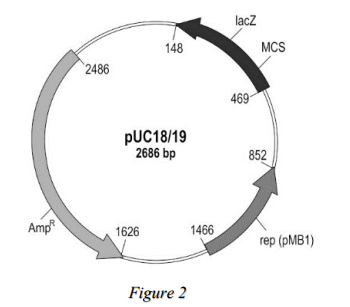
Suggest a method that can help the student in selecting the cells that contain this plasmid. [1]
(xiv) A biotechnological firm aims to manufacture certain clotting factors to treat Haemophilia in patients. Mention any one aspect to be considered while choosing the transgenic animal to produce these clotting factors. [1]
(xv) A group of virologists aim to inhibit the activity of reverse transcriptase enzymes as part of their effort to find a solution to viral infections. Which aspect of the virus’s function would be impacted by inhibiting the activity of reverse transcriptase? [1]
(xvi) Answer the following questions: [2]
(a) In recombinant DNA technology, biologists use the enzyme restriction endonuclease. Name the scientist who discovered this enzyme.
(b) Expand the abbreviation MMR.
(xvii) The figure given below shows a stage in the formation of pollen grain. [1]
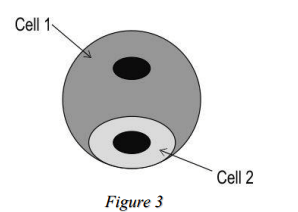
Name the cell that undergoes further division to make gametes.
(xvi) Give a reason for each of the following: [2]
(a) For a breastfeeding mother, the chances of conception are very low.
(b) Organ transplantation patients are given the drug cyclosporine.
Section B – 14 Marks
Question 2 [2]
A couple does not wish to have more children. Suggest and briefly explain any two methods of family planning that are highly effective and have low chances of failure, for the couple to consider.
Question 3 [2]
In a population of 5000 individuals, 1800 do not have freckles on their faces (ff), while the remaining individuals have freckles (F).
Assuming that the population is in Hardy-Weinberg equilibrium for the presence of freckles, calculate the expected frequencies for the following genotypes:
(i) FF genotype
(ii) ff genotype
Question 4 [2]
Shown below is the karyotype of an individual.
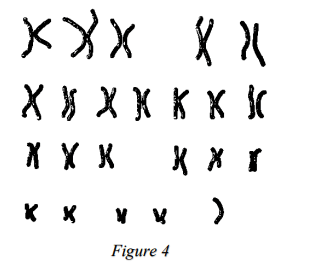
(i) State one characteristic reproductive feature and one physical attribute of such an individual.
(ii) What is the category of such disorders called? Which abnormality during cell division causes such disorders?
Question 5 [2]
(i) Study the diagram of a human ovum given below and answer the questions that follow.
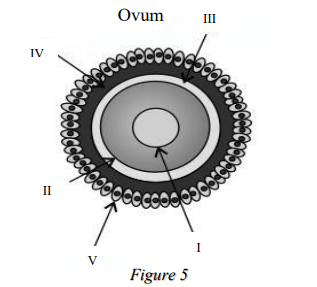
(a) Identify and name the part of the ovum that prevents its fertilisation by multiple sperm.
(b) What is the mode of action of the part identified in (a)?
OR
(ii) The diagram given below represents a specific stage of human embryonic development. Study it carefully and answer the questions that follow.
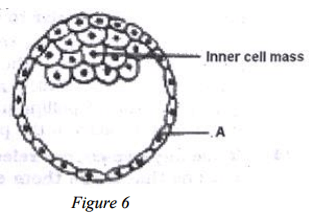
(a) Name the stage of human embryo represented by the given diagram.
(b) Identify the part labelled ‘A’ and mention its function.
(c) What happens to the inner cell mass after implantation?
Question 6 [2]
A group of researchers in a pharmaceutical company aims to produce a specific chemical which can treat viral infections.
Which specific group of chemicals should they isolate? How would it help in treatment of viral infection?
Question 7 [2]
Explain any two types of evidence for biological evolution.
Question 8 [2]
The figure shown below is a representative image of an antibody. Study it carefully and answer the questions that follow.
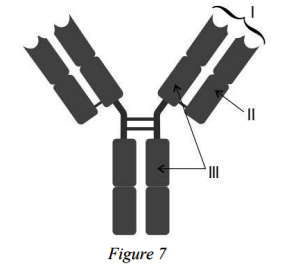
(i) A person is infected by a pathogen. Identify and name the part of the antibody that the pathogen binds to.
(ii) A few years later, this person is infected by a different variant of the same pathogen. Would the existing antibodies be able to recognise and bind to it now? Justify your answer by giving one reason.
Section C – 21 Marks
Question 9 [3]
The diagram given below shows various phases of the menstrual cycle in human beings.
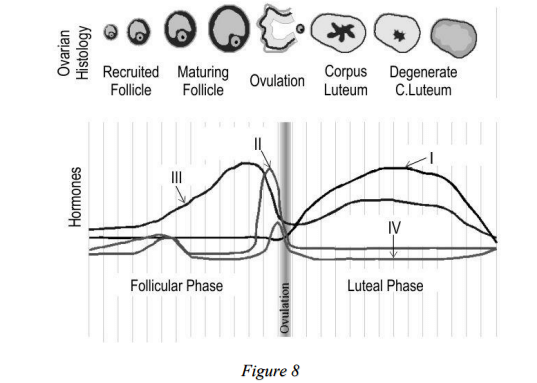
(i) Identify the plotlines that represent the following:
(a) Progesterone
(b) Luteinizing hormone
(ii) Give any two differences between Menstrual cycle and Estrus cycle.
Question 10 [3]
As a part of an experiment, Kavya, David and Abdul had to cut a plasmid which is 650 bp long to insert a gene of interest. All of them worked on this task individually. As per the protocol, the restriction enzyme was incubated for two hours with the plasmid. After some time, they loaded their sample onto the same agarose gel for electrophoresis.
Given below is an image of the agarose gel where sample A belongs to Kavya, sample B to David and sample C to Abdul.
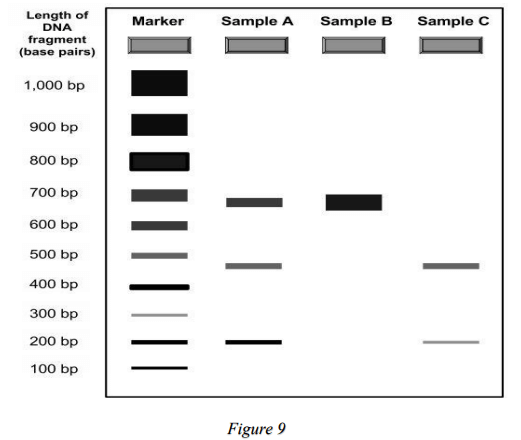
(a) If Abdul has performed the experiment correctly, what is the reason for the difference in the band pattern in Kavya’s and David’s samples?
(b) According to Abdul, only a gene of the size of 200 bp can be inserted into this plasmid as this is the size of DNA that has been cut out from the plasmid. Is he correct? Justify by giving one reason.
Question 11 [3]
The figure given below shows a mushroom that is connected to the roots of another tree growing near it.
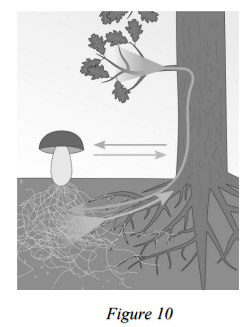
(i) Identify the type of interaction between the mushroom and the roots of the tree.
(ii) Mention any two advantages of this type of interaction.
Question 12 [3]
The homozygous Andalusian chicken exhibits black feathers (BB) and white feathers (WW), while the heterozygous bird has bluish feathers.
(i) If two heterozygous Andalusian chickens are crossed, what are the possible genotypic and phenotypic ratios of their offspring?
(ii) What kind of dominance does the gene for feather colour exhibit? Give a reason to support your answer.
Question 13 [3]
Name the category of microorganisms that aid in biogas production. Provide an example of this category.
Mention any four benefits of biogas compared to other energy sources.
Question 14 [3]
(i) Draw a well labelled diagram of L.S of anatropous ovule.
OR
(ii) Draw a well labelled diagram of mammalian testis.
Question 15 [3]
Explain three different types of parasitism with one example each.
Section D – 15 Marks
Question 16 [5]
(i) Vallisneria is a submerged dioecious hydrophyte. The female flowers of Vallisneria reach the surface of water by their long stalk while the male flowers are released on to the surface of water due to bursting of the inflorescence.
(a) Give any two characteristic features of the pollen grains of hydrophilous flowers.
(b) State whether Vallisneria is adapted for autogamy or xenogamy. Give one reason to justify your answer.
(c) Give any three disadvantages of self-pollination.
OR
(ii) A couple is unable to have children naturally, despite the woman’s ability to ovulate and the man having a normal sperm.
(a) Mention the two different types of abnormalities in sperm, which cause infertility in males.
(b) Suggest any three methods of assisted reproductive technology except GIFT, available to the couple to consider.
Question 17 [5]
What does the term biodiversity mean? Explain four major causes of loss of biodiversity due to human activities.
Question 18 [5]
A research group studied various aspects of a particular region in their gene of interest and its mutated versions. Shown below is a part of the DNA sequence they were studying:
5′ ATG TTG ACA TCA TCC AGC TGT 3′
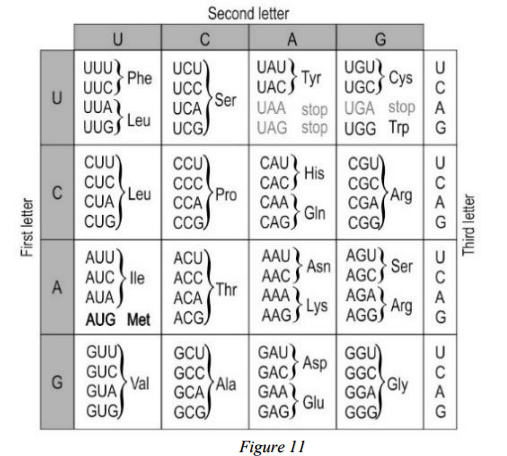
(i) What is the DNA sequence complementary to the above sequence?
(ii) Write the sequence of mRNA transcribed by this segment of DNA.
(iii) Write the amino acid sequence coded by the mRNA sequence, using the genetic code shown in the figure given above.
(iv) A mutant of this gene contains A instead of C in the 11th position in the given DNA sequence. What will be the amino acid sequence coded by this mutant gene?
(v) What type of mutation would the change in nucleotide referred to in subpart (iv) lead to? Justify by giving one reason.

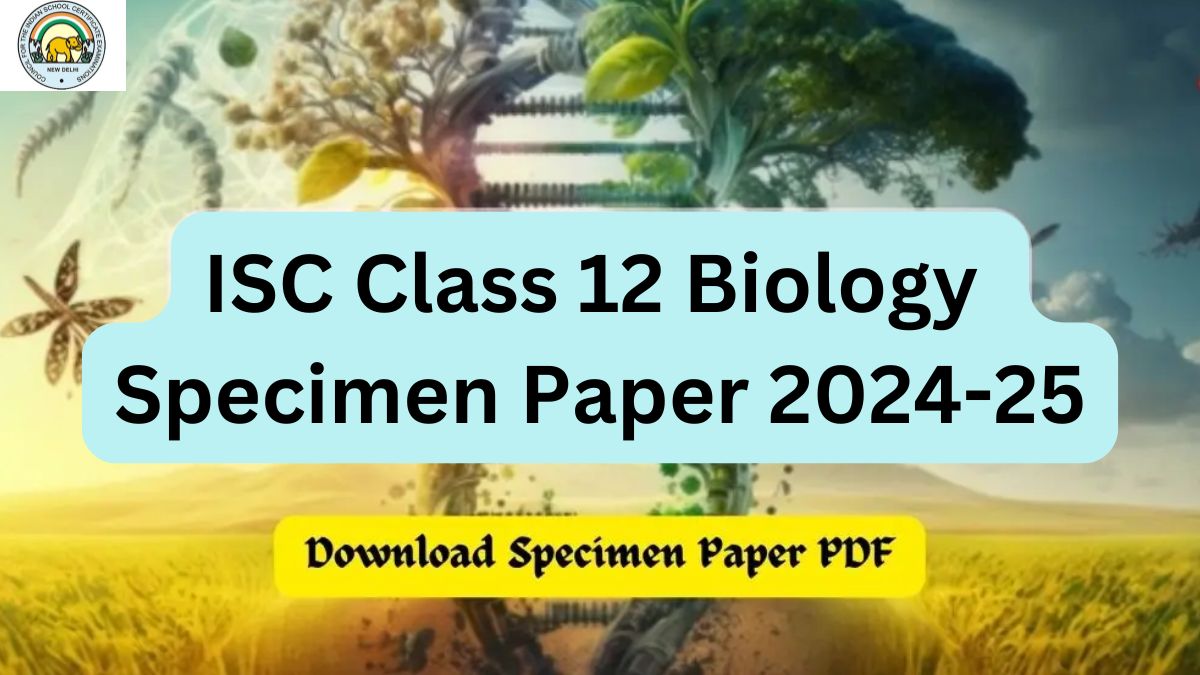








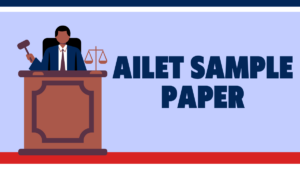 AILET Sample Paper 2026 Out, Download PD...
AILET Sample Paper 2026 Out, Download PD...
 CBSE Class 10 IT Sample Paper 2025-26 PD...
CBSE Class 10 IT Sample Paper 2025-26 PD...
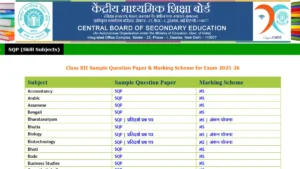 CBSE Class 12 Sample Paper 2026 with Sol...
CBSE Class 12 Sample Paper 2026 with Sol...














